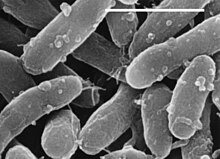ゲンマティモナス門
ゲンマティモナス門(ーもん、Gemmatimonadota)はグラム陰性の細菌門である。2018年現在、記載されたものとしては2綱2目2科2属3種を含む。系統的にはバクテロイデス門-クロロビウム門に近縁で[4]、FCB群に含められることもある。
| ゲンマティモナス門 | ||||||
|---|---|---|---|---|---|---|

| ||||||
| 分類 | ||||||
| ||||||
| 学名 | ||||||
| Gemmatimonadota Zhang et al. 2021[1] (IJSEMリストに掲載 2022[2]) | ||||||
| シノニム | ||||||
| ||||||
| 下位分類(綱) | ||||||
|
2003年に下水処理場の活性汚泥からGemmatimonas aurantiacaが発見されたことで提唱された[3]。
2015年にはゴビ砂漠のスワン湖からGemmatimonas phototrophica[5][6]が、2016年には地中海の森林土壌からLongimicrobium terrae[7]が、発見・記載されている。このほか未記載ではあるが、ミシガン州の管理された有機農場から"Gemmatirosa kalamazoonesis"が発見されている[8]。
何れも、中温性で好気性の従属栄養細菌であり、グラム陰性桿菌である。Longimicrobium terraeは貧栄養環境に適応しており、最適条件でも世代時間は13.5時間と長い[7]。また、Gemmatimonas phototrophicaは、炭素固定能は無いが、バクテリオクロロフィルaと光化学系IIを持ち、活性は低いが光と有機物、酸素存在下で光従属栄養的にも増殖できる[5][6]。
脚注
編集- ^ Aharon Oren and George M. Garrity (25 October 2021). “Valid publication of the names of forty-two phyla of prokaryotes”. International Journal of Systematic and Evolutionary Microbiology 71 (10): 5056. doi:10.1099/ijsem.0.005056. PMID 34694987.
- ^ Aharon Oren and George M. Garrity (02 February 2022). “Notification that new names of prokaryotes, new combinations, and new taxonomic opinions have appeared in volume 71, part 10 of the IJSEM”. International Journal of Systematic and Evolutionary Microbiology 72 (1): 5165. doi:10.1099/ijsem.0.005165.
- ^ a b Zhang H, Sekiguchi Y, Hanada S, Hugenholtz P, Kim H, Kamagata Y, Nakamura K (2003). “Gemmatimonas aurantiaca gen. nov., sp. nov., a gram-negative, aerobic, polyphosphate-accumulating micro-organism, the first cultured representative of the new bacterial phylum Gemmatimonadetes phyl. nov.”. International Journal of Systematic and Evolutionary Microbiology 53 (Pt 4): 1155–63. doi:10.1099/ijs.0.02520-0. PMID 12892144.
- ^ Castelle, C.J., Banfield, J.F. (2018.03.08). “Major New Microbial Groups Expand Diversity and Alter our Understanding of the Tree of Life”. Cell 172 (6): 1181-1197. doi:10.1016/j.cell.2018.02.016. PMID 29522741.
- ^ a b Zeng, Y., et al. (2015). “Characterization of the microaerophilic, bacteriochlorophyll a-containing bacterium Gemmatimonas phototrophica sp. nov., and emended descriptions of the genus Gemmatimonas and Gemmatimonas aurantiaca”. International Journal of Systematic and Evolutionary Microbiology 65 (8): 2410-9. doi:10.1099/ijs.0.000272. PMID 25899503.
- ^ a b Zeng, Y., et al. (2017). “Erratum: Characterization of the microaerophilic, bacteriochlorophyll a-containing bacterium Gemmatimonas phototrophica sp. nov., and emended descriptions of the genus Gemmatimonas and Gemmatimonas aurantiaca”. Int. J. Syst. Evol. Microbiol. 67 (2): 521-522. doi:10.1099/ijsem.0.001859. PMID 28234578.
- ^ a b Pascual, J., et al. (2016). “Longimicrobium terrae gen. nov., sp. nov., an oligotrophic bacterium of the under-represented phylum Gemmatimonadetes isolated through a system of miniaturized diffusion chambers”. International Journal of Systematic and Evolutionary Microbiology 66 (5): 1976-85. doi:10.1099/ijsem.0.000974. PMID 26873585.
- ^ DeBruyn, J.M., et al. (2013). “ Gemmatirosa kalamazoonesis gen. nov., sp. nov., a member of the rarely-cultivated bacterial phylum Gemmatimonadetes”. J. Gen. Appl. Microbiol. 59 (4): 305-12. PMID 24005180.